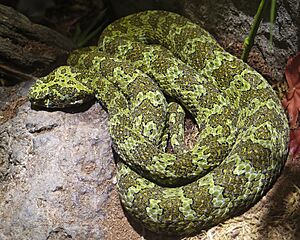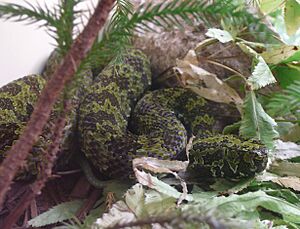Mangshan pit viper facts for kids
Quick facts for kids Protobothrops mangshanensis |
|
|---|---|
 |
|
| Conservation status | |
| Scientific classification | |
| Genus: |
Protobothrops
|
| Species: |
mangshanensis
|
| Synonyms | |
|
|
The Protobothrops mangshanensis, often called the Mangshan pit viper, is a special kind of venomous snake. It lives only in certain parts of China, in the Hunan and Guangdong provinces. This snake is active at night, which means it's nocturnal.
People also know this snake as the "Mangshan iron-head snake" or "Ironhead viper." It eats different animals like frogs, birds, insects, and small mammals. The Mangshan pit viper has a clever way to hunt: it wiggles its white tail tip to make it look like a worm. This trick, called caudal luring, helps to attract prey close enough to strike.
The venom from this snake can cause serious problems, like making blood clot and damaging muscles. If someone is bitten, they need medical help right away. Unlike most vipers, which give birth to live young, the female Mangshan pit viper lays eggs. She lays about 13 to 21 eggs and stays to guard them until they hatch.
Contents
About the Mangshan Pit Viper
The Mangshan pit viper is a fairly large snake. Adult snakes can weigh between 3 and 5 kilograms (about 6.6 to 11 pounds). They can also grow quite long, reaching up to 203 centimeters (about 6.6 feet).
Sometimes, people mistakenly think this snake can "spit" venom, like some cobras do. However, scientists have shown that the Mangshan pit viper does not spit its venom. It delivers venom through a bite, like other pit vipers.
Where the Mangshan Pit Viper Lives
This unique snake is found in southern China. Its main home is in the Mangshan mountain range, located in Yizhang County, Hunan province. It also lives in nearby areas, including Ruyuan Yao Autonomous County in Guangdong province. These areas are known for their beautiful mountains.
Protecting the Mangshan Pit Viper
The Mangshan pit viper is listed as an "Endangered" animal by the IUCN. This means it is at a high risk of disappearing forever. There are only a few places where this snake lives, and its habitat is quite small.
One big reason it's endangered is that people illegally catch these snakes. They are wanted for the international pet trade, and some are also caught to be eaten as a local delicacy. Because of these threats, the number of adult Mangshan pit vipers continues to decrease.
Mangshan Pit Viper Habitat
This pit viper lives in mountainous areas in southern Hunan and northern Guangdong. It can be found at elevations between 800 and 1300 meters (about 2,600 to 4,200 feet) above sea level. It prefers subtropical montane forests, which are mountain forests with lots of thick plants and places to hide.
The snake often waits on lichen-covered logs or other structures along animal trails to ambush its prey. You might also find it in the many limestone caves found in the region. The weather in these mountains can vary a lot. Winter temperatures can get close to freezing, while summer temperatures can reach 30 degrees Celsius (86 degrees Fahrenheit) or even higher.
How the Mangshan Pit Viper Got Its Name
The scientific name of an animal can sometimes change as scientists learn more about it. This snake was first placed in a group called Trimeresurus. Later, a new group called Ermia was created for it, named after a Chinese snake expert, Zhao Ermi.
However, it turned out that the name Ermia was already being used for a type of locust. So, scientists had to find a new name, and they chose Zhaoermia. More recently, in 2007, new studies showed that this snake fits better into the group called Protobothrops. That's why its current scientific name is Protobothrops mangshanensis.
Reproduction and Life Cycle
The Mangshan pit viper has an interesting way of reproducing. Unlike many vipers that give birth to live young, this species is oviparous, meaning the female lays eggs. She typically lays a clutch of 13 to 21 eggs. After laying her eggs, the female snake stays with them. She guards her eggs carefully until they hatch, protecting them from danger. This behavior is unusual for vipers.
See also
- List of crotaline species and subspecies
- Snakebite



